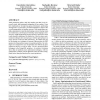Free Online Productivity Tools
i2Speak
i2Symbol
i2OCR
iTex2Img
iWeb2Print
iWeb2Shot
i2Type
iPdf2Split
iPdf2Merge
i2Bopomofo
i2Arabic
i2Style
i2Image
i2PDF
iLatex2Rtf
Sci2ools
SIGMOD
2011
ACM
2011
ACM
Query optimization techniques for partitioned tables
Table partitioning splits a table into smaller parts that can be accessed, stored, and maintained independent of one another. From their traditional use in improving query performance, partitioning strategies have evolved into a powerful mechanism to improve the overall manageability of database systems. Table partitioning simplifies administrative tasks like data loading, removal, backup, statistics maintenance, and storage provisioning. Query language extensions now enable applications and user queries to specify how their results should be partitioned for further use. However, query optimization techniques have not kept pace with the rapid advances in usage and user control of table partitioning. We address this gap by developing new techniques to generate efficient plans for SQL queries involving multiway joins over partitioned tables. Our techniques are designed for easy incorporation into bottom-up query optimizers that are in wide use today. We have prototyped these technique...
Database | Database Management Systems | Query Optimization Techniques | Query Optimizers | SIGMOD 2011 |
Related Content
| Added | 17 Sep 2011 |
| Updated | 17 Sep 2011 |
| Type | Journal |
| Year | 2011 |
| Where | SIGMOD |
| Authors | Herodotos Herodotou, Nedyalko Borisov, Shivnath Babu |
Comments (0)

